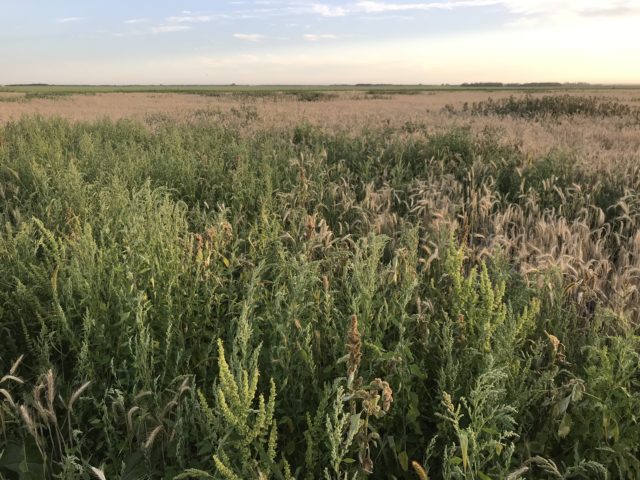
By Tammy Jones
Pre-harvest is a strategic window of opportunity for weed control. It is an extremely useful tool for certain weeds in certain situations, but has limitations and serious consequences if not thought out completely. That may sound alarming, but it is a fact. Applying the wrong type of herbicide to a crop at the pre-harvest timing may affect crop yield, quality or marketability. So, it is important to assess the situation before using this tool. The main questions to answer:
• Which weeds are a concern?
• Which herbicide options are available?
• What impact does this have on marketing the crop?
Which weeds are a concern?
Pre-harvest herbicide applications can manage weed escapes from the growing season, but typically are focused on optimizing perennial weed control. A secondary benefit to the weed management is the opportunity for increased ease in direct combining of standing crops, which in turn can maximize yield and benefit quality. Even if you plan to swath the crop, pre-harvest weed control is more effective for managing perennial weeds than cutting them off.
The timing for herbicide control options for tough perennials such as quackgrass, Canada thistle, dandelion, perennial sowthistle and even milkweed or yellow toadflax is when the plant is shifting or has shifted from growth to reproductive stage. There are some pre-seed and in-crop herbicide options that help minimize the growth and therefore the impact of these weeds on crop yield potential, but the best time for control is typically closer to harvest time. At this time of the year, days start to shorten, nights get cooler and perennial weeds begin to shift from above-ground growth to replenishing root reserves to survive another tough winter. Getting to that root provides the most effective long-term herbicide control of perennial weeds.
Conversely, annual weeds are likely more suited to an herbicide application that results in rapid dry-down of plant material and a quick kill to prevent seeds from maturing or being viable. That is not usually achieved with the slow translocation and death of the plant when using glyphosate (at least 7 to 14 days). In that case, swathing or desiccation works well. Since desiccants are contact herbicides, the effects may be noticeable within hours or days. Contact herbicides do not translocate through the plant, resulting in great top growth control, but no impact on rooting systems of perennial weeds. Keep in mind that desiccants typically break down cell walls, which is helpful for rapid dry down, but that also means that plant structure starts to deteriorate and if there is a delay in harvest, the crop may not stand as well after desiccation.
Getting back to that pure pursuit of weed control, another factor to consider is the staging of the target weed for most effective control. The crop and weed combination may mean that pre-harvest glyphosate is not going to be the best option. Early maturing crops such as peas or winter wheat may be ready to harvest before the weed is at an appropriate stage. Conversely, later maturing crops such as conventional soybeans or fababeans may be too immature for glyphosate application when the weed is at the correct stage. Typically, the weed should be in the bud to early bloom or early heading stage to achieve the best result. In the case of earlier maturing crops, it may still be a benefit to apply the pre-harvest herbicide, with a reduced expectation of efficacy, but with a later maturing crop, other control options will have to be explored. Always refer to and follow the product label for the correct timing.
Which herbicide options are available?
The most commonly used active ingredient used for pre-harvest weed management is glyphosate. There are other herbicides approved for pre-harvest application, but they function as desiccants. The table outlines the registered options for pre-harvest herbicides and their associated function. There are also products that are pre-packaged mixes of active ingredients including glyphosate (which is not a desiccant) and desiccant products, which affects application timing as well as other parameters, especially water volume and pre-harvest interval.
What impact does this have on marketing the crop?
Thoroughly investigate a pre-harvest herbicide prior to application on a particular crop. Off-label herbicide use can result in an unmarketable product. Most farmers are aware that glyphosate is unacceptable for use on malt barley or crops for seed production as it may negatively affect germination of the harvested product. Increasingly sensitive herbicide residue testing has resulted in increased consumer awareness, and end-use buyers making specific requirements even when a particular product may be registered for use on a particular crop. An excellent source of information on emerging issues is Keep it Clean (keepingitclean.ca), which details pre-harvest intervals, and provides information on meeting export standards, maximum residue limits and herbicide/crop combinations that result in a marketable product.
Pre-harvest herbicide applications have been tested extensively to ensure efficacy but also safety to consumers. The label is vital in providing information on rates, staging and pre-harvest intervals (the time between the application of a pre-harvest herbicide and the time when it is swathed, combined or otherwise harvested for use). Remember, desiccants or glyphosate have no impact on crop maturity and desiccants applied alone will not help with perennial weed control.










